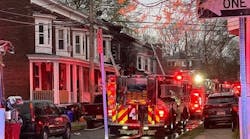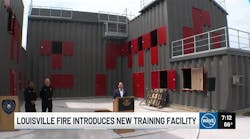Today's fire apparatus specifications are lengthy, hard to read and not easily understood. The specification-writing process has turned into a flamboyant affair with superfluous wording, eloquent sayings and indefinable descriptions by both buyer and seller. Apparatus manufacturers and dealers use the written word to make their product and themselves more appealing to the customer. Some pride themselves for having the longest, thickest and most detailed specification in the industry. When describing what they want to buy, some purchasers will emulate a manufacturer's lengthy specification. Professional specification writers and industry consultants can have equally long and detailed methods of writing.
Caution should be exercised. Having sold or purchased a few fire trucks should not be the only qualifications of an industry expert. Being up to date and innovative in ideas, theories and thinking is equally as important as having decades of experience. Think twice if the last rig your consultant sold had an open cab, gasoline engine, four-speed manual transmission, Class B pump and subway loops for the crew riding the back step.
Regardless of the reason, both buyer and seller use an abundance of verbiage. There are too many words and far too many adjectives. Textbooks define an adjective as a word that describes or qualifies another word or subject. You may rest assured that no high school English teacher is going to grade your apparatus specification. It should be written so prospective bidders can easily read and understand it. Looks don't count — content does.
Superfluous wording clouds the bidding process. Superfluous wording includes unnecessary words, descriptions and meaningless phrases used in attempting to enhance the value of an item. They do not always do so in a measurable way because they may have more than one meaning or have no clear meaning at all. There is nothing that is quantifiable; nothing can be accurately defined or measured. They are those extra words with no value that clutter up fire apparatus specifications. And as such, they cannot be priced by a bid estimator. A competitive cost cannot be established for a description that may have different meanings to different people. Get rid of those extra words. This writer predicts the current industry-wide specification format will be shortened and simplified. Abbreviated or bullet-type specifications, predominant in Europe, will soon become commonplace in the domestic market. Advantages to simplified specifications include, but are not limited to:
- They are easy to write
- They are precise and to the point
- There is less chance of misinterpretation
- They are easily understood by non-scholarly purchasers
- They lessen the potential for error
- They are easy to modify
- They take less time to prepare
- They take less time to read and understand
- They will encourage competitive bidding
- They can be easily integrated into existing specification-writing software
Bidders place a monetary value on every word written into a set of purchasing specifications. They know the exact cost difference between three-16ths-inch aluminum and one-eighth-inch stainless steel compartment shelves. But, they may not be able to estimate what is specified as a heavy-duty shelf because heavy duty has no single meaning. Manufacturers of both 3/16ths-inch aluminum and 1/8th-inch stainless shelves advertise each as heavy duty! A one-eighth-inch shelf with a reinforcing hat section or one constructed of quarter-inch-thick aluminum plate could also be interpreted as heavy duty and be equally as functional. There is no valid description or single cost for heavy duty. There is no doubt what the intent is, but it is nearly impossible to place a monetary value on intent alone. Bidders can price a shelf with a single, double or even triple break on the leading edge, but are hard pressed to estimate the cost of one specified to be manufactured to meet the demands of the fire service. If you want the shelf to hold 500 pounds without permanently deflecting, say so.
Purchasers should be aware that manufacturers of component parts such as warning lights, fire pumps, valves, booster tanks, generators and the like have their own product specifications, which can be long, detailed and proprietary. Apparatus manufacturers and ultimately end users incorporate component-part specifications into a single document. One manufacturer's specification for a light bar is almost 400 words long. If that particular unit is available to all manufacturers and a purchaser wants to specify it, it can be done by name and model number only. Under the warning light section of the document, merely specify a Brand XYZ Model 1234 light bar. That should suffice, saving reading and writing 390 unnecessary words. Purchasers may consider a general statement in their specifications similar to: "When a specific manufacturer's model number is specified for a vendor supplied part, the purchaser considers it the same as if that manufacturer's standard specification is written in full herein." Should a purchaser opt not to specify a vendor supplied part by make and model number, an adequate description should be provided detailing features and performance criteria desired. Descriptions should be comprehensive and meaningful.
Imagine you are the purchaser at a pre-bid conference and prospective manufacturers are asking you the following questions from your specifications:
- Your specification reads: "The manufacturer shall supply two (2) complete and detailed operation and maintenance manuals." How do you define "complete and detailed"? How do you tell a complete manual from an incomplete one? If the intent is to compare and evaluate the manuals you may receive, then specify exactly what you expect to be provided in them.
- Your specification describing grab handles with ribbed non-slip surfaces states: "The ribs shall be close enough together for a good gripping surface, but not so close as to prevent easy cleanup if soiled." How do you figure that one out? Do you rub dirt on it and see how hard it is to clean? Just stating a ribbed non-slip surface should be enough.
- Your compartment specification describing the leading edge of a compartment shelf (the part you see when you open the door) states: "….the exposed exterior lip shall be highly polished." Can you define "highly polished"? Does it cost more than lightly polished? Is it expensive?
- Describing delivery requirements, your specification says: "The apparatus shall be suitably protected against damage from road debris in transit." What does "suitably protected" mean? Do you want an extra coat of wax on the front of the cab when it is delivered? Or will a temporary bug deflector made out of cardboard and duct tape work? Fifty years ago, this requirement meant you shipped the apparatus by rail. Be specific or be silent.
- Your specification reads: "This apparatus shall be specifically designed and manufactured for heavy-duty fire service." If it is not specifically or purposely or explicitly or exclusively designed for the fire service, do you think it was accidentally designed? What is the difference between light-duty and heavy-duty fire service — fewer calls per year or more potholes in the streets? If the intent is to accept bids for a custom cab and chassis designed only for the fire service and not a commercially available cab and chassis, say so.
- Your specification says: "The cab interior shall be styled by professional automotive designers." Does "professional" mean a degreed engineer? If so, what kind of degree is acceptable? What's wrong with a heavy-truck designer? Leave that part out.
- Your rescue truck specifications states: "The body windows shall include solar management treatment." Does that mean tinted glass or something similar to a thermal-paned window? What do you want this solar management treatment to do? Be definitive.
- Your painting specification reads: "The final finish shall be to the highest fire apparatus standards." What is the definition of a paint job "to the highest fire apparatus standards"? Does it cost more than one to the lowest fire apparatus standards? Is it different than a paint job to commercial standards or automotive standards? If you consider it important, define the painting process in detail.
- Another specification says: "Each access step shall incorporate a light with a common bulb." Most people would rather have a common bulb than an uncommon one, but what is the difference? Does common mean the same in Colorado as in Connecticut? Do you care what kind of bulb is used? If it matters, specify it in a manner that can be understood — by size or make and model number.
- This is a good one; it is probably the only superfluous requirement that makes sense. Several specifications require that with the delivery there shall be supplied: "One (1) bag of chrome, stainless-steel or cadmium-plated screws, nuts, bolts and washers as used in the construction of the unit." But, how many of each do you get in a bag? What size bag? Paper or plastic?
This writer is not implying your entire specification should be nebulous and vague. Do not eliminate verbiage that lessens the level of quality and performance expected. Be precise with your wording and exacting in your descriptions. Don't mince words, but don't waste them either.
Place an imaginary monetary value for every word you write into your specifications. You can be assured the manufacturers do. Say what you mean or don't say it at all.
WILLIAM F. ADAMS is a past chief of the East Rochester, NY, Fire Department and a former fire apparatus sales representative. He has 40 years' experience in the volunteer fire service.





